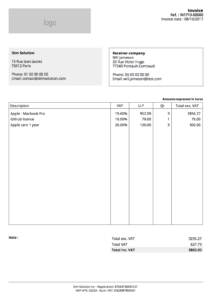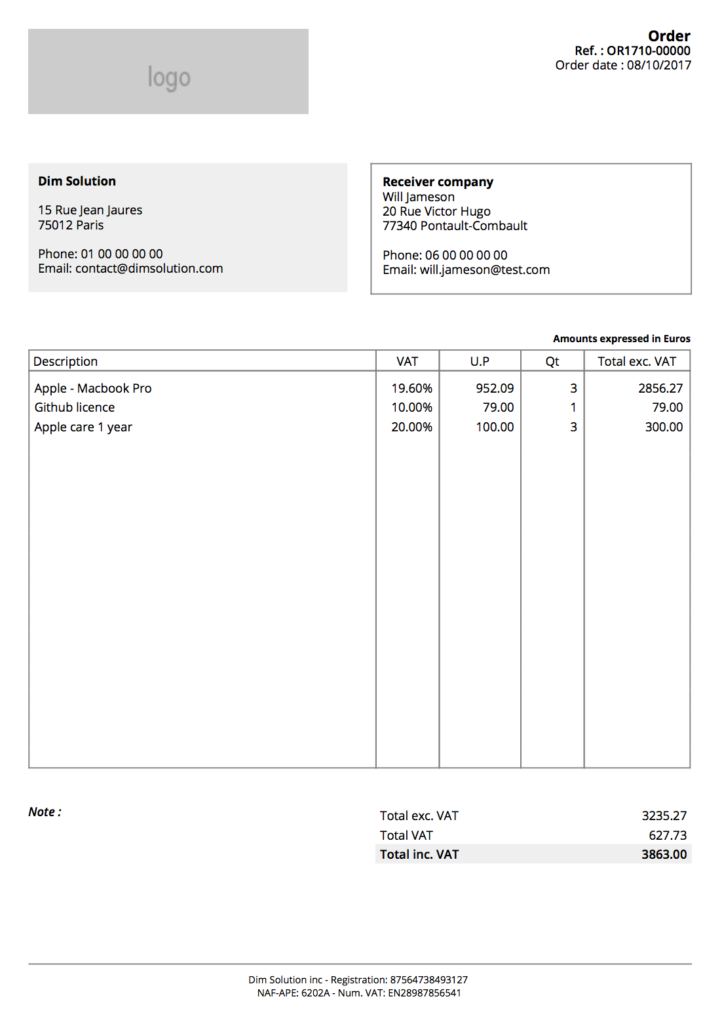Introduction
This tutorial aims to show you how use @rimiti/invoice-it (Github, NPM) NodeJS package to easily generate invoice or order PDF files.
Invoice-it is production ready since July 1st, 2017. It use PhatomJS (Scriptable Headless Browser) from html-pdf package, which is embedded by invoice-it to convert html templates to PDF.
Why invoice it?
Invoice-it has been created to be fully customizable and supporting multi page. You can easily override default configuration to:
- Use your own order and invoice templates.
- Add your logo.
- Change date format.
- Change default locale.
- Add / use your own locales file (to override wording).
- Add order and invoice notes.
- Customize you company informations (company name, address, phone, website, footer…).
- Change document identification format (example: IN-1805-00001).
- …
Let’s go!
As an example, let’s generate a first order containing the items below:
- Macbook Pro 13″ – (x3)
- Github licence – (x1)
- Apple care 1 year – (x3)
To be in real condition, I’ll fully customize the document with following informations:
Emitter:
Dim Solution
73 rue Victor Hugo
77340 Pontault-Combault
Phone: +33 0 00 00 00 00
Email: contact@dimsolution.com
Recipient:
Will Jameson
20 rue de Paris
75001 Paris
Phone: 00 00 00 00 00
Email: will.jameson@customer.com
Our footer company informations:
Dim Solution inc – Registration: 87564738493127
NAF-APE: 6202A – Num. VAT: EN28987856541
To don’t pass every time emitter and logo informations, you can configure it and exporting it.
| 1 2 3 4 5 6 7 8 9 10 11 12 13 14 15 16 17 18 19 20 21 22 23 24 25 26 |
import invoiceIt from '@rimiti/invoice-it'; // Configuration invoiceIt.configure({ emitter: { name: 'Dim Solution', street_number: '15', street_name: 'Rue Jean Jaures', zip_code: '75012', city: 'Paris', country: 'France', phone: '01 00 00 00 00', mail: 'contact@dimsolution.com', website: 'www.dimsolution.com', }, global: { logo: 'http://placehold.it/230x70&text=Dim+Solution', lang: 'en', footer: { fr: 'Société par Actions Simplifiée Unipersonnelle (SASU) - Capital de 1 000 000 € - SIRET: 87564738493127 <br> NAF-APE: 6202A - Num. TVA: FR28987856541', en: 'Dim Solution inc - Registration: 87564738493127 <br> NAF-APE: 6202A - Num. VAT: EN28987856541' }, }, }); export default invoiceIt; |
Adding recipient informations:
| 1 2 3 4 5 6 7 8 9 10 11 12 13 14 15 16 17 |
// Import customized instance import invoiceIt from 'lib/invoiceIt'; const recipient = { first_name: 'Will', last_name: 'Jameson', street_number: '20', street_name: 'Rue Victor Hugo', zip_code: '77340', city: 'Pontault-Combault', country: 'France', phone: '06 00 00 00 00', mail: 'will.jameson@customer.com' }; // Prepare document const document = invoiceIt.create(recipient); |
There are two ways for adding articles in a document.
From an array:
| 1 2 3 4 5 6 7 8 9 10 11 |
document.article = [{ description: 'Macbook Pro 13"', tax: 19.60, price: 952.09, qt: 2, }, { description: 'Github licence', tax: 10, price: 79, qt: 5, }]; |
From object:
| 1 2 3 4 5 6 |
document.article = { description: 'Apple care 1 year', tax: 20, price: 100, qt: 3, }; |
It’s time to export our document ?
Invoice-it provides several formats to export document.
HTML
| 1 2 3 4 5 6 7 8 9 10 11 |
// Export order to HTML file. document.getOrder() .toHTML() .toFile('./exports/order.html') .then(() => console.log('Order HTML file created.')); // Export invoice to HTML file. document.getInvoice() .toHTML() .toFile('./exports/invoice.html') .then(() => console.log('Invoice HTML file created.')); |
| 1 2 3 4 5 6 7 8 9 10 11 |
// Export order to PDF file. document.getOrder() .toPDF() .toFile('./exports/order.pdf') .then(() => console.log('Order PDF file created.')); // Export invoice in PDF document.getInvoice() .toPDF() .toFile('./exports/invoice.pdf') .then(() => console.log('Invoice PDF file created.')); |
Isn’t it awesome ? 🙂

Invoice PDF

Order PDF
Extras
Some others examples to demonstrate you how to customize some fields:
| 1 2 3 4 5 6 7 8 |
// If you want to add note to your order document.order_note = 'Your order note...'; // If you want to add note to your invoice document.invoice_note = 'Your invoice note...'; // To delete all articles document.deleteArticles(); |
The code present in this tutorial is accessible into this repository.
If you want more examples or snippets, you can check the official repository.
9 comments
Nicks65
Posted on 29 mai 2018 at 21 h 29 minThank you for this nice tutorial.
Dimitri DO BAIRRO
Posted on 29 mai 2018 at 22 h 55 minThank you @Nicks65! 🙂
ouss
Posted on 29 mai 2018 at 22 h 21 minawesome pdf generator !
Dimitri DO BAIRRO
Posted on 29 mai 2018 at 22 h 55 minThank you @ouss! 🙂
Alex Ellis
Posted on 30 septembre 2018 at 23 h 41 minI really like this – it’d make an awesome function in the OpenFaaS Function Store. What do you think Dimitri?
Dimitri DO BAIRRO
Posted on 4 octobre 2018 at 11 h 32 minThank you @Alex! You’re right, this module could indeed be the subject of a nice example of using OpenFaas! I’ll will soon create a new article about it. ?
Daniel
Posted on 12 février 2019 at 13 h 40 minHey man! Could you please fix the header and footer so that if the amount of products is too big, next products should go on the second page, but after the header?
Thanks for this! You rock!
Dimitri DO BAIRRO
Posted on 12 février 2019 at 13 h 44 minHello Daniel,
Thank you for your feedback.
Could you please create an issue on Github with an example of what’s wrong ?
Github repository.
Thanks ?
Daniel
Posted on 12 février 2019 at 14 h 22 minAnother thing.. I try to use your module with express. I also want to be able to structure the generated HTML files. Unfortunately, .toFile() method does not create a new directory if it doesn’t exists, and that prevent from organizing files. Could you please have a look? Thanks!